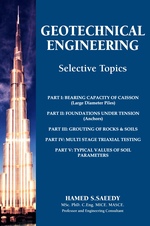
About the Author: Hamed Salem Saeedy
Prof. Hamed Saeedy, completed his first engineering qualification (civil) at Kingston College, Surrey, England in 1962. He obtained his M.Sc. from the Colorado State University in 1968 in Structural Engineering, and his Ph.D. from Oklahoma State University, U.S.A. in Geotechnical Engineering in 1971, during that time he was teaching and granted research and teaching assistance for two years at the same university. During the year 1969 he was the Chief Structural Engineer with Ardaman and Associate, Orlando, Florida
In 1971 through 1983 he was an associate professor, chairman of Civil Engineering Dept., and then became the Dean of the College of Engineering, University of Basra. During 1981-1983, he was visiting Professor at Sheffield University, UK.
During 1984-1990 he was a senior Researcher at Kuwait Institute for Scientific Research. Since 1971, he practiced Civil Engineering Consultancy on various local and regional civil and geotechnical engineering projects and challenging engineering problems.
He was a member of the Institutions for Civil Engineers and Chartered Engineers (London) since 1973, also member of the American Society of civil engineers .
He has published numerous scientific papers, consultancy legal reports, textbooks, and technical manuals. He travelled worldwide, attending scientific conferences and seminars.
Presently, he is an International Engineering Consultant, he owns and associates with various engineering consultancy bureaus, in the region and abroad.

This book is a bouquet of various advanced topics, all relate to the same field of Geotechnical Engineering, it comprises of five parts they are:
PART I Bearing Capacity of Caissons (Large Diameter Piles)
PART II Foundations under Tension (Anchors)
PART III Grouting of Rocks and Soils
PART IV Typical Values of Soil Parameters
PART V Multi Stage Trixial Testing
Part I, deals the analysis of bearing capacity of large diameter piles, they technically known as caissons. Of closed and open ended. The theoretical approach consist a vast applications of variety of theorems combined with tables and graphical solutions.
Part II, It is mostly dealing with determination of pullout capacity of foundations normally subjected to pullout forces, where the theoretical approach predicts the pullout capacity of the vertical anchors, this is usually applied to support high transmission of electricity, or to stable partially or fully submerged structures or pipe lines.
Part III, focuses on applied technique to improve troublesome soils and very weak rocks, technically named as Grouting, it is an engineering procedure to remedies foundations or dam embankments and ground cavities, by injecting soil base or chemical materials for purpose to strengthen or seal the soil media.
Part IV, contains very value technical information and data usually needed in the design of foundations for super structures, particularly during the initial stages of design.
Part V, this concerns with normally costly soil testing procedure called Triaxial Test. It requires the use of three undisturbed soil samples to perform the test, where this part discusses in depth how to use a single undisturbed soil sample to accomplish the same results.
 This book is a bouquet of various advanced topics, all relate to the same field of Geotechnical Engineering, it comprises of five parts they are:
This book is a bouquet of various advanced topics, all relate to the same field of Geotechnical Engineering, it comprises of five parts they are: